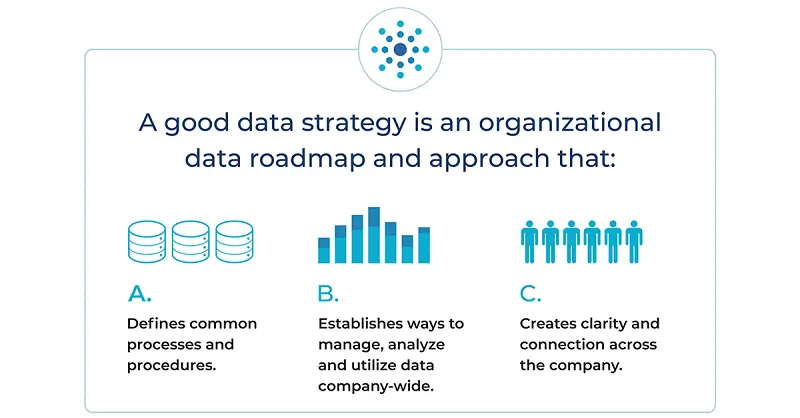How to Build a Data Strategy for Your Business (And Why)

In today’s data-driven world, bulks of data or Big Data are being generated continuously by every one of the digital gadgets, systems, and processes all around us. However, only a small percentage of businesses are harnessing and using this Big Data to inform their business processes.
The reason very few businesses utilize this data is mainly because of an inability for brands, entrepreneurs, and other professionals to gather, organize, and manage all of the available data. But, to experience the real power of data, it is highly advisable that you design a solid data strategy as data is now a key factor for success for businesses of all types.
But what exactly is a data strategy and how can you develop it to position your business among the data-rich organizations that are projected will dominate the market for the next 20 years?
What Is Data Strategy?
A data strategy is basically the systematic method(s) of how a company gathers, stores, handles, and shares data along with a plan to put that data into action. The main goal of a data strategy is to use data with efficiency to achieve productivity and business goals.
Now you may be wondering what are the possible challenges involved in this process?
Well, every organization has data, but each business’ data is unique when compared to others. So, knowing what to do with your existing data is what matters when creating a data strategy.
To ensure you create a successful data strategy, it is vital to:
- Collect and analyze all the available data in your business, including web traffic analytics, subscribers’ actions, sales numbers, and conversion figures.
- Understand how the available data assets can help you yield better profits when turned into valuable insights and action plans for enhanced productivity and achieving business goals.
- Outline the expected outcomes of putting data to action and completing the activities required to achieve targeted results.
- Make any changes within the organization if needed to maximize the value of the data gathering, activities and outcomes.
- Fix timelines for the completion of all the activities based on the priorities highlighted by data.
- Discuss suggested data activities and how it benefits the company financially. That entails planning data strategies for using the data insights to raise profits, besides making data a marketable asset for monetizing the business.
Be particular about putting data strategies to action throughout this process, as well as adjust the strategies as needed based on your current circumstances.
The value of managing data in this way and having a solid data strategy in place is great.
Data Benefits for Businesses

Most of the big organizations understand and recognized data is one of the most valuable resources today. And thus only a few organizations, mainly big tech companies like Google and Meta, leverage new technologies for productive usage of the data in their possession. As such, these are the companies and businesses that experience the real power of data.
Sadly, most small businesses and entrepreneurs are not completely sure of how to use the data they have properly or how a data monetization strategy can benefit their work and startups. And then they wonder how it is that they are not really making an impact in their market.
Unlocking the real value of data can raise your profits to dizzying heights, although that is exactly the biggest challenge for any business. How do you unlock the power of your data?
Organizations - big and small - may know how to collect data and store it safely. However, once the data is collected, the challenge arises of how to convert that data into a usable format. Keep in mind that the privacy of the data is paramount, even when sharing data within the organization and drawing insights from that data.
And that is why having a data strategy is essential to drive the possible best actions and ensure data safety and consistency throughout every step of the way in every single action.
If you want to know even more why having a data strategy is important and why data can benefit your business activities, you only need to look at some of the key statistics of Big Data.
Explosion (& Massiveness) of Big Data
The world's recorded knowledge is growing much more rapidly than ever. According to the U.S. Chamber of Commerce Foundation, an affiliate of the U.S. Chamber of Commerce, digital information is now being created, analyzed, and stored at an astonishing rate. Over 90% of the world's data has been produced in just the last two years, per the commerce foundation. This explosion of information is known as “Big Data,” and it is completely transforming the world around us.
“The main driver of Big Data is the nearly incalculable amount of transactional data being produced by companies, financial institutions, and online intermediaries, writes the foundation. “This includes trillions of bytes of information about buyers, suppliers, and operations of critical interest to businesses and financial analysts.”
The fact that the world is revolving around Big Data means that it is critical to plan strategies for handling and managing these massive volumes of data. And the ratio at which Big Data grows means the challenge to handle and manage the massive data is not something to take lightly. You need to implement a solid data strategy to keep up with the fast data flow and manage it properly.
Instead of resolving issues related to data with an on-point temporary solution, it is vital to fix it more efficiently with a permanent solution. That will ensure efficient data management.
The data strategy you create therefore must be designed with the particular organizational needs in mind, and with various secure modes of access. This type of data management approach guarantees better data security and avoids accidental loss of data.
Practical Usage of Data Resources
Having a data strategy can save lots of time. Besides resolving any data issues or breaches within a short time or immediately after detection, the data is available in a usable format and becomes a marketable asset that can be accessed or retrieved when needed.
To leverage this usable form of data, a business owner, entrepreneur or marketer should first know how to use their existing data assets profitably. For instance, a marketer should be aware of:
- how to gather data,
- how to use the collected data,
- how apps leverage data to make money, and
- how websites use data to make money, and other similar data-related strategies.
The outcome of any data strategy should therefore be aimed at increasing business profits. This type of plans can be included in the Data Strategy under a category like Uses of Data Resources.
Some of the principles and tactics for building a solid data strategy you may need to incorporate in the planning phase, include:
- Integrate Data Management platforms to avoid data duplication and improve accuracy. After that, involve data-driven technologies to use the data efficiently.
- Follow pre-determined Data Strategy or method to collect and share data with more consistency.
- Collect data from reliable sources, besides deriving the real value to it through data structuring and ready-to-share and use data format.
- Maintain a business glossary and metadata with information about the existing data like location, folder name, size, type and other help to retrieve the data file easily on searching.
- Define relevant goals for data management along with its usage. These goals drive the drafted data strategies with activities enhancing the process handling the data resources.
- While achieving the goals, it's crucial to monitor the progress besides having a vision through updation of information as per the Data Strategies. Make sure to set goals for each component of data strategy, which includes data gathering, storage, maintenance, sharing.
With all the principles and tactics mentioned above considered, you are now ready to create your Data Strategy
Steps to Create Your Own Data Strategy
You can follow these steps to create a solid data strategy for your business or startup and improve your marketing processes:
- Proposal to develop a Data Strategy to the management of the organization, where applicable. Explain to them how Data Management becomes feasible with a solid Data Strategy and get approval.
- Select a team to allocate resources and draft policies for regulating any data issues that may or are expected could arise in the future.
- Segregate the audience based on certain unique factors to identify and use those audience segments in future. If needed scale the audience data by buying 3rd party data, 2nd party data or collaborating with a credible 2nd party data partner.
- Know which audience segments have higher demand and use them further for future campaigns.
- Outline goals and plan strategies that’ll be used to implement processes and technologies that are needed to grow profits for at least the next 5 years.
- Estimate and plan for Data Storage Requirements, including a reliable Data management system and strategy to access, share, and use data quickly whenever required.

Conclusion
A solid data strategy can add immense value to your business and career. It can help grow revenues through the actionable, shareable, and monetizable insights you manage. Build your data strategy to turn your business into a future-proof, data-rich and data-driven success.




















